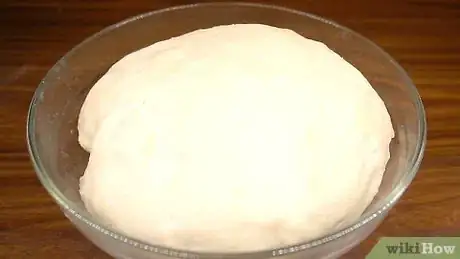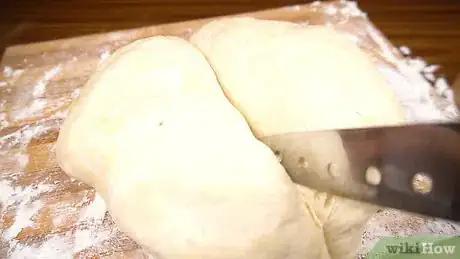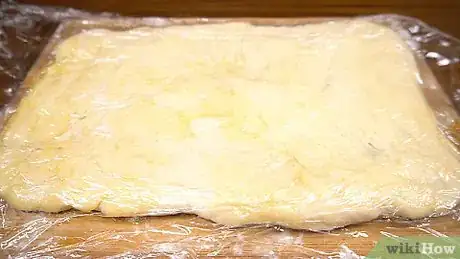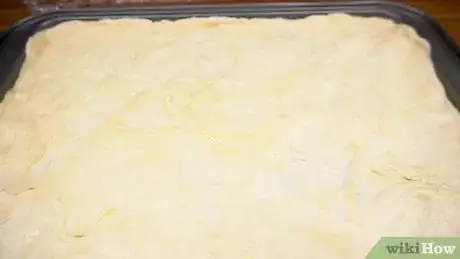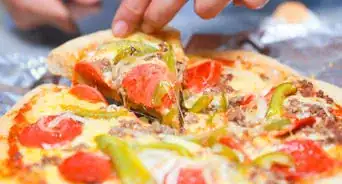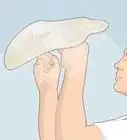This article was co-authored by Alex Hong and by wikiHow staff writer, Jessica Gibson. Alex Hong is the Executive Chef and Co-Owner of Sorrel, a New American restaurant in San Francisco. He has been working in restaurants for over ten years. Alex is a graduate of the Culinary Institute of America, and has worked in the kitchens of Jean-Georges and Quince, both Michelin-starred restaurants.
wikiHow marks an article as reader-approved once it receives enough positive feedback. This article received 18 testimonials and 90% of readers who voted found it helpful, earning it our reader-approved status.
This article has been viewed 2,997,551 times.
If you're tired of ordering the same old pizza for delivery, make your own customized pizza at home. Give yourself enough time to mix together a flavorful dough and let it prove. Once it's doubled in size, roll the dough into any size pizza (or pizzas) you want. Pre-bake the dough and then put sauce and toppings on your pizza. Bake it until the cheese melts and the crust becomes golden brown.
Ingredients
- 2 teaspoons (6 g) of active dry yeast or instant yeast
- 7⁄8 to 1 1⁄8 cups (210 to 270 ml) plus 2 tablespoons (30 ml) of lukewarm water, divided
- 2 tablespoons (30 ml) of olive oil
- 3 cups (361 g) of unbleached all-purpose flour
- 1 1/4 teaspoons (7 g) of salt
Makes enough dough for 1 to 2 round pizzas or 1 rectangular pizza
Steps
Mixing the Dough
-
1Dissolve active dry yeast in 2 tablespoons (30 ml) of water. If you're not using instant yeast, put 2 teaspoons (6 g) of active dry yeast into a small bowl. Add a pinch of sugar and 2 tablespoons (30 ml) of the lukewarm water. Stir until the yeast is dissolved and let it sit for 5 minutes at room temperature.[1]
- The yeast should bubble and foam up once it's activated.
- If you're using instant yeast, you don't need to dissolve it or add sugar.
-
2Put the yeast into a bowl with oil, flour, salt, and 7⁄8 cup (210 ml) of water. If you're using the activated yeast, pour it into a large mixing bowl. If you're using instant yeast, measure 2 teaspoons (6 g) into the mixing bowl. Add 3 cups (361 g) of unbleached all-purpose flour to the bowl along with 2 tablespoons (30 ml) of olive oil, 1 1/4 teaspoons (7 g) of salt, and 7⁄8 cup (210 ml) of lukewarm water.[2]
- Avoid putting the salt directly onto the instant yeast because it will kill the yeast.
- You can add the remaining water later if the dough looks dry, but start with the smaller amount.
Advertisement -
3Stir the ingredients to make a sticky dough. Use a sturdy spoon, stand mixer, or bread machine to mix the dough ingredients. Stir until they're completely combined and you don't see pockets of flour.[3]
- If the dough seems too dry, you can stir in the remaining 1⁄4 cup (59 ml) of lukewarm water, a spoonful at a time.
- If you're using a stand mixer, use the dough hook attachment. Don't use a hand mixer to make this dough because it's not powerful enough to mix the dough.
-
4Knead the pizza dough until it's soft, smooth, and stretchy. To knead the dough by hand, coat your hands with flour and sprinkle your work surface with a little flour. Use the palms of your hand to push the dough away from you so it stretches. Then turn the dough 45 degrees and fold it in half. Push the dough away again and continue to turn and fold the dough. Knead until the dough becomes soft and elastic.[4]
- To knead the dough using a stand mixer, choose the second lowest speed and beat the dough for 4 to 5 minutes.
- To knead the dough using a bread machine, set the machine to run a dough cycle.
Proving and Shaping the Dough
-
1Put the dough in a bowl and prove it for 1 to 1 1/2 hours. To prevent the dough from sticking to the bowl, lightly grease it before you put the dough in it. Then cover the bowl and leave the dough to rest at room temperature until the yeast causes it to rise. The dough should nearly double in size and become puffy once it's ready to shape.[5]
- If you used instant yeast, begin checking the dough after 1 hour of proving. If you used active dry yeast, begin checking it after 1 1/2 to 2 hours.
-
2Decide what size and thickness of pizza you want. Since you have control over how many pizzas to make with the dough, you can also choose how thick you want them. This batch of dough will make one of these options:
- Two 1/2 in (1.3 cm) thick round pizzas that are 14 inches (36 cm) in diameter
- Two 3/4 in (1.9 cm) thick round pizzas that are 12 inches (30 cm) in diameter
- One 3/4 to 1 in (1.9 to 2.5 cm) thick rectangular pizza that's 13 by 18 inches (33 cm × 46 cm)
- One 1 1/2 in (3.8 cm) thick rectangular pizza that's 9 by 13 inches (23 cm × 33 cm)
- One 1 in (2.5 cm) thick round pizza that's 14 inches (36 cm) in diameter
-
3Divide the dough if you're making 2 pizzas. Sprinkle a little flour on your work surface and scoop the dough onto it. Then use a knife or bench scraper to divide the dough into 2 equal portions.[6]
- If you're making 1 large round or rectangular pizza, you don't need to divide the dough.
-
4Stretch the dough into circles or a rectangle. Once you've decided the size and thickness of the pizza you want, use your hands to gently stretch the dough. To make a rectangular pizza, start by stretching the entire ball of dough into an oval. Then tug on the corners a little to make a rough rectangle. If you're making round pizzas, stretch each dough half (or the whole ball) into a rough circle.[7]
- Making 1 large rectangle is the classic Italian way to shape pizza dough and it will fit your baking pan better than if you try to make 2 smaller rectangles or squares.
- If you're finding it hard to stretch the dough, you can use a rolling pin to spread the dough a little.
-
5Cover the dough and let it rest for 15 minutes. If you made round pizzas, take bowls that are larger than the diameter of the pizza and turn them over. Place the overturned bowls over the dough. If you made a rectangular pizza, spray a large sheet of plastic wrap with cooking spray and lay it over the dough. Leave the pizza dough to rest for 15 minutes.[8]
- The dough may puff a little as it rests, but it doesn't need to double in volume.
-
6Spray the pizza pans with cooking spray and lay the dough in the pans. If you don't have cooking spray, spread a little olive oil across your pizza pan. Carefully lay the rolled dough in the pan and stretch the edges so they come close to the sides of the pan.
- The olive oil will improve the flavor of the crust and prevent it from sticking to the bottom of the pan.
-
7Rest the dough for 15 minutes and finish stretching it. Cover the dough with a bowl or plastic wrap and leave it at room temperature to rest for 15 minutes. Then remove the bowls or plastic wrap and use your fingers to finish stretching the edges of the dough to the corners of the pizza pan.[9]
- You should be able to fill the entire pizza pan with the stretched dough.
-
8Cover and prove the dough for 1 1/2 hours. Cover the dough with the bowls or plastic wrap and leave it to rest at room temperature. After 1 1/2 hours the dough should be puffy.[10]
- If you're proving dough that you refrigerated, you'll need to prove it for an extra 30 to 60 minutes.
Topping and Baking the Pizza
-
1Preheat the oven to 500 °F (260 °C) and adjust the oven racks. Place a rack on the lowest rung of your oven so the pizzas will bake closest to the heating element. This will give you the crispiest crust.[11]
- If you're using a pizza stone, place it on the lowest rack.
-
2Bake just the dough in the pan for 8 to 14 minutes. Uncover the pans and put the pizza dough into the preheated oven. Bake the dough until it's just starting to set and become brown around the edges. If you're making thin crust pizza, take it out after 8 minutes. For thicker crust pizza, remove it after 12 to 14 minutes.
- The dough won't be finished baking at this point.
- Pre-baking the dough will make the dough chewier.
-
3Spread toppings on your pizza. Cover the pizza dough with your choice of white sauce, red pizza sauce, or pesto. Then top the sauce with your favorite toppings and cheese. Consider using a combination of:[12]
- Pepperoni or ham
- Sausage or ground beef
- Roasted chicken
- Pineapple
- Mozzarella, Asiago, or Parmesan cheese
- Broccoli or bell peppers
- Olives
- Onions
- Mushrooms
-
4Put the pizza in the oven and bake it for 10 to 15 minutes. Place the pizza on the upper rack of the oven and bake the pizza until the cheese melts. The crust should become a golden brown.
- If the pizza crust is browning too quickly, move the pizza to the bottom rack.
-
5Remove the pizza and let it cool for 5 minutes. Turn off the oven and transfer the pizza to a rack or cutting board. Let the pizza cool so the cheese firms up a little and it's easier to slice.
- If the pizza sticks when you try to remove it, slide a firm metal spatula under the crust to loosen it.
-
6Cut and serve the pizza. Decide if you'd like to cut the pizza into triangular slices or smaller squares. Serve the pieces of pizza while they're still hot and set out grated Parmesan cheese and red pepper flakes.
- If you don't have a pizza cutter or knife, use clean kitchen shears to cut pieces of pizza.
- Refrigerate leftover pizza in an airtight container for up to 3 or 4 days.
Expert Q&A
Did you know you can get premium answers for this article?
Unlock premium answers by supporting wikiHow
-
QuestionHow can I make my pizza dough better?
 Alex HongAlex Hong is the Executive Chef and Co-Owner of Sorrel, a New American restaurant in San Francisco. He has been working in restaurants for over ten years. Alex is a graduate of the Culinary Institute of America, and has worked in the kitchens of Jean-Georges and Quince, both Michelin-starred restaurants.
Alex HongAlex Hong is the Executive Chef and Co-Owner of Sorrel, a New American restaurant in San Francisco. He has been working in restaurants for over ten years. Alex is a graduate of the Culinary Institute of America, and has worked in the kitchens of Jean-Georges and Quince, both Michelin-starred restaurants.
Executive Chef & Restaurant Owner I like to refrigerate the dough to let it ferment, which gives it a little bit more of that delicious sour flavor. If you do that, though, you have to remember to temper the dough, which brings it back up to room temperature, so the gluten can rest and the dough becomes much softer and easier to work with.
I like to refrigerate the dough to let it ferment, which gives it a little bit more of that delicious sour flavor. If you do that, though, you have to remember to temper the dough, which brings it back up to room temperature, so the gluten can rest and the dough becomes much softer and easier to work with. -
QuestionCan I use another kind of oil?
 wikiHow Staff EditorThis answer was written by one of our trained team of researchers who validated it for accuracy and comprehensiveness.
wikiHow Staff EditorThis answer was written by one of our trained team of researchers who validated it for accuracy and comprehensiveness.
Staff Answer wikiHow Staff EditorStaff Answer
wikiHow Staff EditorStaff Answer -
QuestionCan I make pizza without baking?
 wikiHow Staff EditorThis answer was written by one of our trained team of researchers who validated it for accuracy and comprehensiveness.
wikiHow Staff EditorThis answer was written by one of our trained team of researchers who validated it for accuracy and comprehensiveness.
Staff Answer wikiHow Staff EditorStaff AnswerYes, fortunately it is possible to do this! You could try making a skillet pizza, cooking a pizza in a solar oven, grilling or barbecuing a pizza, or using a raw food pizza recipe. For some ideas of making pizza without an oven, check out the wikiHow: How to Make Pizza Without an Oven at Home.
wikiHow Staff EditorStaff AnswerYes, fortunately it is possible to do this! You could try making a skillet pizza, cooking a pizza in a solar oven, grilling or barbecuing a pizza, or using a raw food pizza recipe. For some ideas of making pizza without an oven, check out the wikiHow: How to Make Pizza Without an Oven at Home.
Things You'll Need
- Measuring cups and spoons
- Large bowl
- Plastic wrap
- Bowl
- Rectangular baking sheet or round pizza pans
- Pizza cutter or knife
- Cutting board, optional
- Rolling pin, optional
References
- ↑ https://www.allrecipes.com/recipe/16935/pizza-dough-ii/
- ↑ https://www.thekitchn.com/how-to-make-pizza-dough-recipe-221367
- ↑ https://www.thekitchn.com/how-to-make-pizza-dough-recipe-221367
- ↑ https://www.youtube.com/watch?v=Qn5lKmYIOh0
- ↑ https://www.thekitchn.com/how-to-make-pizza-dough-recipe-221367
- ↑ https://www.thekitchn.com/how-to-make-pizza-dough-recipe-221367
- ↑ https://www.thekitchn.com/the-5-key-steps-to-stretching-pizza-dough-255465
- ↑ https://www.foodnetwork.com/recipes/alton-brown/pizza-pizzas-recipe4-1951401
- ↑ https://www.foodnetwork.com/recipes/alton-brown/pizza-pizzas-recipe4-1951401
About This Article
To make pizza dough, first add 2 ½ cups (325 g) of flour and 1 tsp (3 g) of instant yeast to a bowl. Then, add 2 tsp (8 g) of sugar, ½ tsp (3 g) of salt, 1 tbsp (3 g) of dried oregano, and ½ tbsp (5 g) of garlic powder and whisk the dry ingredients together. Add in 2 tbsp (15 ml) of olive oil, and then gradually pour in 1 cup (240 ml) of warm water, folding it into the dry mixture. Continue to mix everything until it sticks together and start to form dough. Flour your work surface and knead the dough for 5 minutes. Shape the dough into a ball with your hands. Next, coat the inside of a bowl with oil, place the dough in it, and cover the bowl with a cloth. Let the dough rise for 1 hour before using it in your recipe. For information on baking your dough, scroll down!
